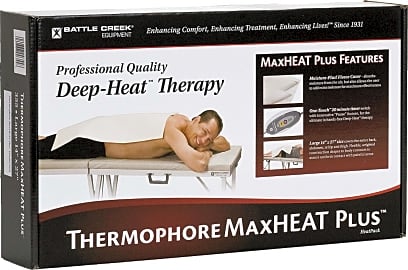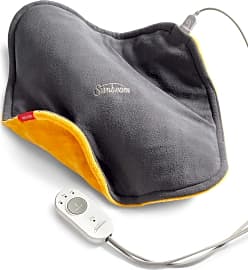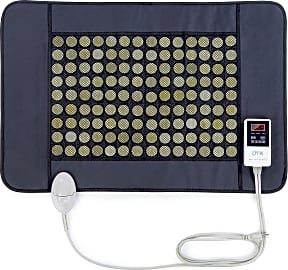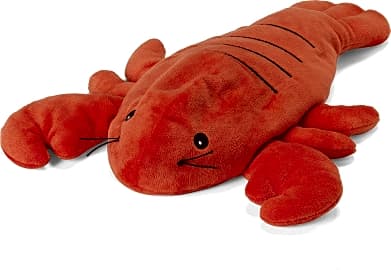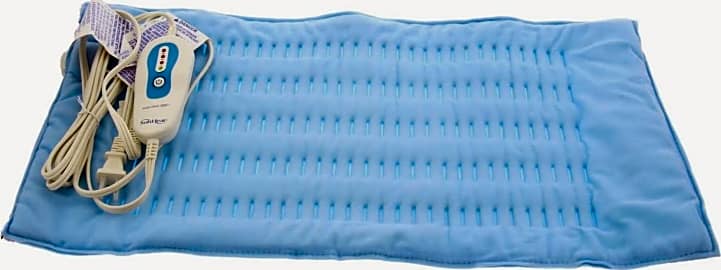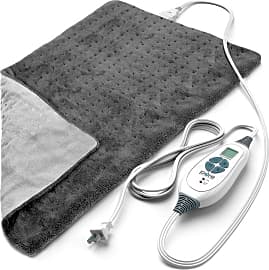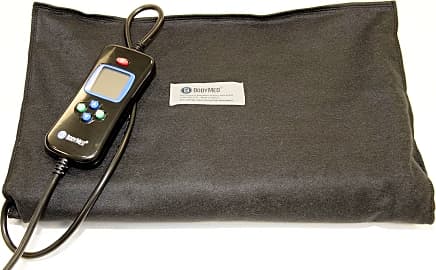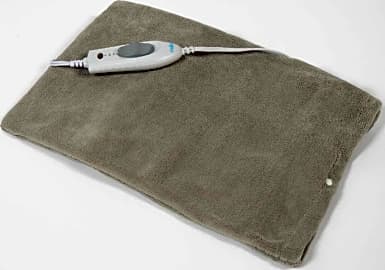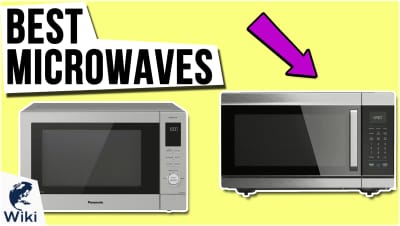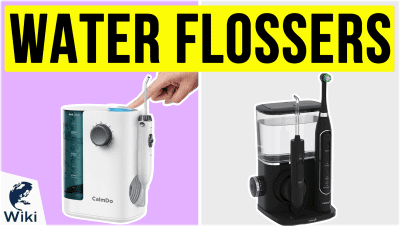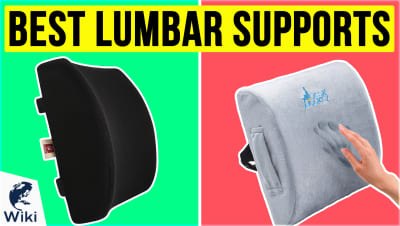The 10 Best Heating Pads

This wiki has been updated 42 times since it was first published in May of 2015. If you prefer to ease sore muscles and aching joints without the use of pain medications, check out our selection of heating pads, ranked by comfort, usability, durability, and price. They can give you the relief you need with no negative side effects when used properly. We've included both electric, self-heating models as well as some that rely on an external source, such as a microwave. When users buy our independently chosen editorial choices, we may earn commissions to help fund the Wiki.
Editor's Notes
November 27, 2020:
With this update, we have revisited our assessment of the Pure Enrichment PureRelief XL, eventually deciding to add it. The company currently offers a strong 5-year warranty and good customer support, which is very helpful should your unit be one of the unlucky ones that begins to display an error message. Plus, we like that it has six settings, which is more than most, so everyone can use it comfortably. And as for safety, it seems likely that many issues can be attributed to user error, so if you opt for this model, be sure to read and heed all safety guidelines.
But when it comes to top choices, we've kept the Mighty Bliss Large and the Battle Creek Thermophore MaxHeat Plus, and added the Sunbeam ConformHeat. The weighted construction of the latter is good not only for keeping it in place, but also for providing better heat transfer than much of the competition. It's a little smaller than many, however.
As for microwavable choices, we decided to remove the Thrive Natural Clay, since the beads tend to clump instead of spreading out flat. Instead, we added the fun Intelex Warmies Plush, which is a cute stuffed animal, in a range of designs, that you pop into the microwave — as wrong as that seems. They're filled with an all-natural grain that holds heat, so you can cuddle up next to your new sloth, lobster, or chimp pal while you relax or fall asleep. If you plan to give one to a child, though, remember that you'll want to inspect the seams from time to time, since the filling should not be ingested.
November 05, 2019:
We may have updated our selections, but we are still focused on those that are easy to use, effective, and, of course, safe. But it's worth noting that even heating pads with a slew of safety features can cause harm when used improperly. For this reason, it's important to follow all manufacturer directions, and never fall asleep while using an electric model.
And speaking of safety, after much deliberation, we have opted to remove the popular PureRelief XL. Reports of problems with this model continue to grow, and although some of this is undoubtedly down to user error, its track record with safety is nonetheless troubling. Luckily, the similar Mighty Bliss Large is available; it doesn't have as many temperature settings as the former, but its brilliant blue cover is a nice touch, as is its uncomplicated controller. We've also opted to remove the Sunny Bay Body Wrap, as its seams simply can't handle day-to-day abuse. But we still like the Thrive Natural Clay and SoftHeat Whole Body for non-electric options. Just be cautious when using them in a microwave without a turntable. When placed in one position for long heating times, they could singe (just like any other similar model).
Finally, for a targeted option, we've selected the Sunbeam Contoured. It's made specifically for the back and will stay in place thanks to the waist strap. Of course, it's not as versatile as most other choices, but like a good back brace, it's a fine tool for those who are fighting back pain.
Special Honors
Biomat Health Mini Biomat The design information given for the Biomat Health Mini Biomat reads like something straight out of a scientific marketing fever dream; the fact remains, however, that it does provide soothing heat therapy with its amethyst and tourmaline crystals. That is, if the price doesn't send your muscles right back into a spasm. biomathealth.com
Hyperice Venom Created with athletes in mind, the Hyperice Venom not only heats but also vibrates, so it can more effectively loosen and limber tight muscles. Its neoprene construction isn't too restrictive, so you won't feel restrained or strangled, whether you choose the back, leg, or shoulder version. hyperice.com
Natural Body Comfort Neck Wrap If it's neck pain or tension that's got you down, you might let the Natural Body Comfort Neck Wrap bring you some relief. It's shaped to conform to your shoulders, neck, and upper back, so there's no fighting to keep it in place. Plus, it's offered in a range of fabrics, both plain and patterned. etsy.com
How Does a Heating Pad Work?
In the case of an electrical pad, the power is provided via an outlet.
Most of today's household heating pads are what have become known as "electrical pads" (as opposed to chemical heating pads, or the now-antiquated hot water bottle). In the case of an electrical pad, the power is provided via an outlet. Once you turn it on, you can choose a heat setting (most blankets have somewhere between 5 and 10 settings). The electricity generates heat that is distributed by way of nichrome coils that lie beneath at least one layer of plastic or fabric safely separating those coils from the skin. Still, you should strictly regulate your electrical heating pad to ensure it doesn't get too hot. Most pads also come with some type of automatic shutoff function to prevent them from becoming fire hazards.
The primary purpose of a heating pad is to relieve tension. Muscle tension constricts blood flow, resulting in pain. Applying heat causes a person's blood vessels to dilate, creating increased circulation and stimulating the affected area. Repetitive use of heat therapy will more than likely result in decreased inflammation, temporary pain relief, increased range of motion, and long-term wellness (among other benefits).
Assuming you're on the go, there are several non-electrical heating pads that you can warm up by placing in a microwave, before either wrapping them around the affected muscle, or strapping them across the back with the use of some kind of harness.
What Do I Need to Know About a Heating Pad Before I Buy?
Most people purchase a heating pad for one of two reasons - either they need something that can provide them with relief from muscle pain, or they want something that can keep them warm. Knowing which of these camps you fall into makes it a lot easier to determine which type of heating pad might make the most sense.
Knowing which of these camps you fall into makes it a lot easier to determine which type of heating pad might make the most sense.
Let's assume you're in the market for a pad that can help you with your muscle pain. You'll want something that has several different heat settings and doesn't take up too much space. You'll also want to research whether the pad is ideal for wrapping around the leg and arm muscles (as opposed to just providing relief to the back). Certain pads come with Velcro straps so they can be used like a harness. Your doctor may recommend alternating between hot and cold therapy, which means you'll probably want a non-electrical pad. A lot of these pads can be either heated up (by placing them in a microwave), or made ice-cold (by leaving them in a freezer).
If, on the other hand, you're looking for a pad that can keep you warm, you'll want the dimensions to be wide so you can absorb heat across a broad swath of your body, and you'll also want to ensure that the pad doesn't come with a lot of wires, or thick coils. There are a ton of pads like this on the market, and some of them are even designed to lie flat beneath a fitted sheet, so you can warm the entire bed with the flip of a button. Assuming you may want to place the pad on a reclining chair or couch, it may be worth considering whether a certain pad is available in a matching color.
A Brief History of The Heating Pad
In their earliest inception heating pads came in the form of a metal (or rubber) water bottle, which was heated, and then placed upon a strained or injured muscle to provide relief. The "hot water bottle," as it came to be known, has been in existence since the early 16th century. In its earliest incarnation, a hot water bottle was sometimes filled with burning coals, which were, in turn, used to warm a bed.
The electrical heating pad has been around since the early 1900s.
The primary difference between these antiquated water bottles and the electrical heating pads of today resides in the versatility, convenience, and impact that today's models offer. The number of settings on an electrical heating pad has gone from zero to infinity. In addition, there are built-in features that keep today's models from overheating. There are also automatic timers that tell the pad when to turn off. Certain non-electrical pads lock in their warmth from a microwave, and these pads are often designed to function as cooling pads, as well.
The electrical heating pad has been around since the early 1900s. It was originally introduced as a bed warmer that would sit beneath the fitted sheet, providing warmth and comfort throughout the night. While there are still electrical heating pads that are used for this purpose, most pads are designed for providing relief to injured muscles or aching joints. The concept remains very similar to that of a heated water bottle, sure, but the technology has become such that people can expect a much more concentrated result.


